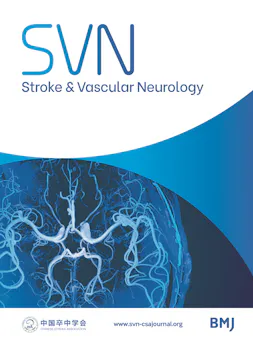前瞻性队列研究:轻微中风患者在症状出现后 72 小时内接受双重抗血小板疗法的最佳疗程
IF 4.9
1区 医学
Q1 CLINICAL NEUROLOGY
引用次数: 0
摘要
目的 尽管存在潜在的溢出效应,但在症状出现 72 小时内对轻微卒中进行双联抗血小板治疗的最佳持续时间仍不确定。方法 阿司匹林-氯吡格雷治疗急性非心源性轻微缺血性卒中(美国国立卫生研究院卒中量表(NIHSS)评分≤5 分)的安全性和有效性是一项前瞻性队列研究,涉及症状出现 72 小时内的轻微缺血性卒中患者。DAPT 组又分为三个亚组:持续时间较短(21 天)。主要疗效和安全性结果为 90 天内的复合血管事件和严重出血。结果 在3061名符合条件的患者中(年龄为61.7±12.0岁,73.3%为男性,NIHSS评分中位数(IQR)为2(1-3)),2977人(97.4%)完成了随访。61.0%的患者接受了双联抗血小板疗法(DAPT),39.0%的患者接受了单联抗血小板疗法(SAPT)。其中,305 名患者(16.8%)接受了时间较短的 DAPT,937 名患者(51.7%)接受了时间较短的 DAPT,572 名患者(31.5%)接受了时间较长的 DAPT。在倾向加权 Cox 比例危险回归分析中,与 SAPT 组相比,短时段组使用 DAPT 与较低的主要血管事件结局风险相关(HR (HR)=0.66, 95% CI 0.46 to 0.94, p=0.02)。90天严重出血事件的发生率相似。倾向评分匹配分析也得出了类似的结果。结论 对于 72 小时内的轻微卒中,短程 DAPT(10-21 天)优于 SAPT,可在不增加出血风险的情况下减少 90 天的复合血管事件。支持本研究结果的数据可向通讯作者索取。通讯作者对本研究数据负责。本文章由计算机程序翻译,如有差异,请以英文原文为准。
Optimal duration of dual antiplatelet therapy for minor stroke within 72 hours of symptom onset: a prospective cohort study
Objectives Despite the potential spillover effect, the optimal duration of dual antiplatelet therapy for minor stroke within 72 hours of symptom onset is still uncertain. Methods Safety and Efficacy of Aspirin-Clopidogrel in Acute Noncardiogenic Minor Ischemic Stroke (National Institutes of Health Stroke Scale (NIHSS) score≤5) is a prospective cohort study involving patients with minor ischaemic stroke within 72 hours of symptom onset. The DAPT group was further categorised into three subgroups: shorter duration (<10 days), short duration (10–21 days) and long duration (>21 days). The primary efficacy and safety outcomes were composite vascular event and severe bleeding during 90 days. Results Among 3061 eligible patients (age was 61.7±12.0 years, 73.3% were men, median (IQR) NIHSS score, 2 (1–3)), 2977 (97.4%) completed the follow-up. Dual antiplatelet therapy (DAPT) and single antiplatelet therapy (SAPT) were administered in 61.0% and 39.0% of patients. Among them, 305 patients (16.8%) received a shorter duration of DAPT, 937 patients (51.7%) received a short duration and 572 patients (31.5%) received a long duration. In the propensity-weighted Cox proportional hazards regression analysis, the use of DAPT in the short-duration group was associated with a lower risk of the primary vascular event outcome (HR (HR)=0.66, 95% CI 0.46 to 0.94, p=0.02) compared with SAPT group. The incidence of severe bleeding events at 90 days was similar. Similar findings were obtained from the propensity score-matching analysis. Conclusion Short duration of DAPT (10–21 days) is superior to SAPT in minor stroke within 72 hours, reducing 90-day composite vascular events without increasing bleeding risk. The data that support the findings of this study are available from the corresponding author upon reasonable request. The corresponding author is responsible for the data in this study.
求助全文
通过发布文献求助,成功后即可免费获取论文全文。
去求助
来源期刊

Stroke and Vascular Neurology
Medicine-Cardiology and Cardiovascular Medicine
CiteScore
11.20
自引率
1.70%
发文量
63
审稿时长
15 weeks
期刊介绍:
Stroke and Vascular Neurology (SVN) is the official journal of the Chinese Stroke Association. Supported by a team of renowned Editors, and fully Open Access, the journal encourages debate on controversial techniques, issues on health policy and social medicine.
 求助内容:
求助内容: 应助结果提醒方式:
应助结果提醒方式:


